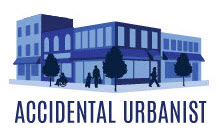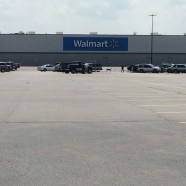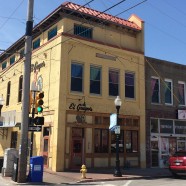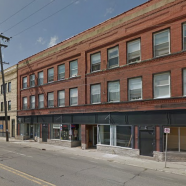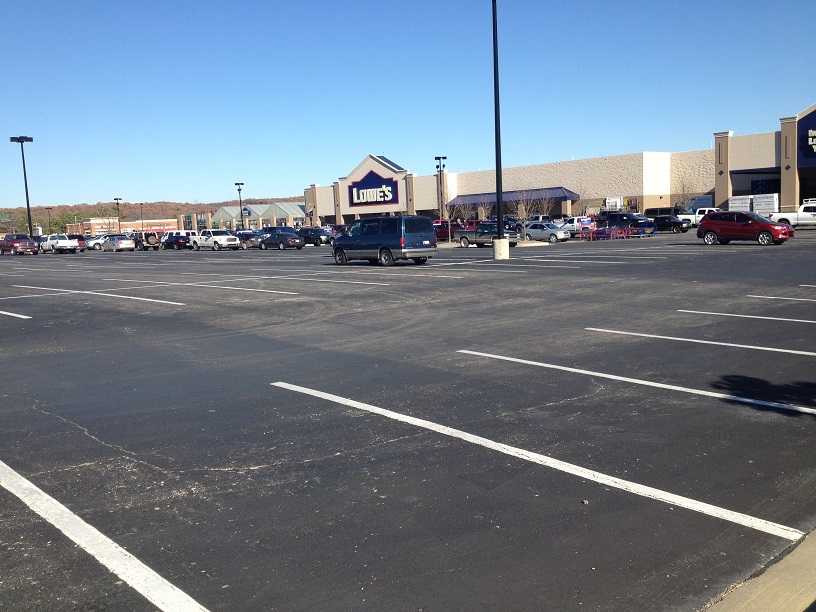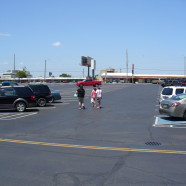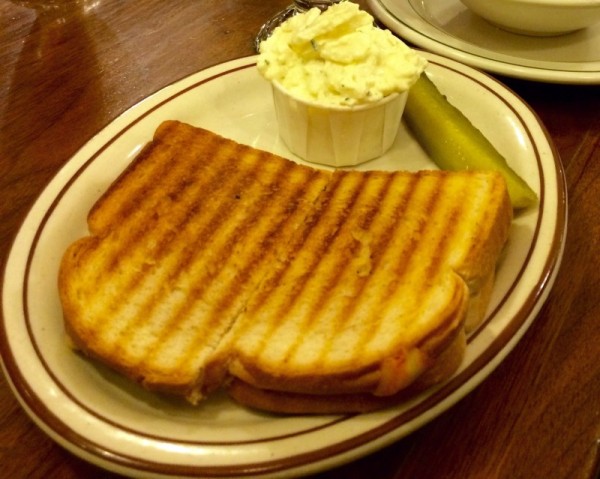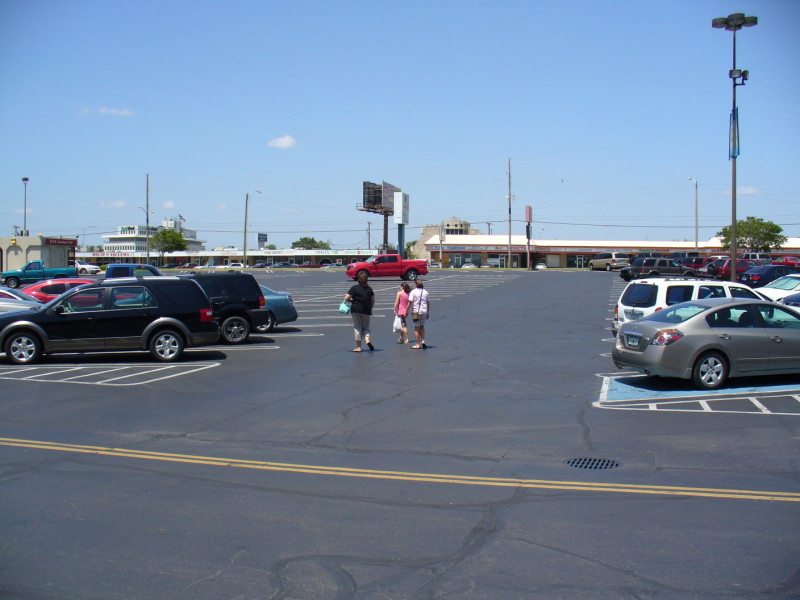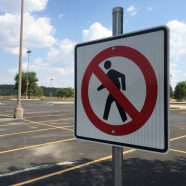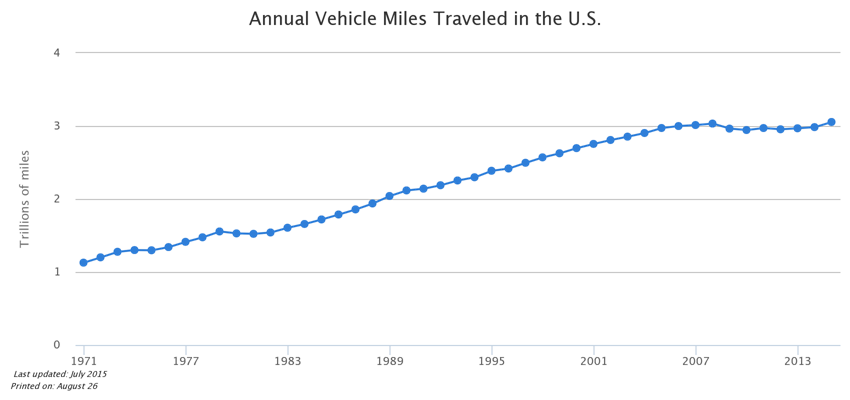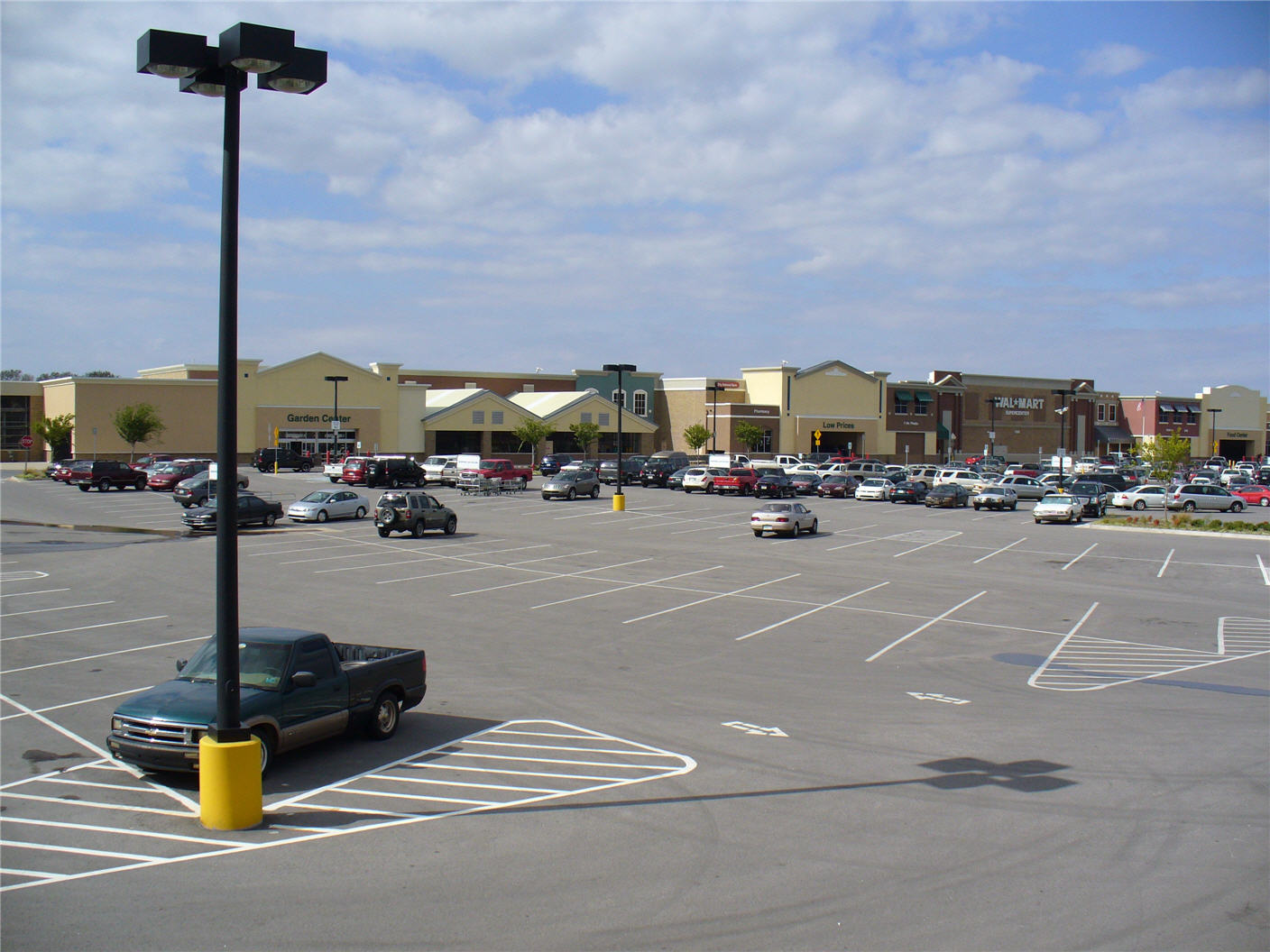Generica the Fungible…?
What does it mean when every city in America starts to look like every other place?
What does it mean when your city’s character is defined by the standards of ubiquitous national chains?
We created a little video to talk about this issue.
See if you can guess where these photos were taken. I bet you can’t.
Read More
Key to Education Funding: The Ground Beneath Our Feet
If you care about Tulsa’s future, you care about public education. Having watched in awe as our state legislature convulsed to the end of yet another cringe-worthy session, one thing is certain: education funding is obviously not the top priority of those in control at the capitol.
So what can be done? Let’s talk about what we can achieve at the local level, without ever taking a trip down the turnpike.
If you look at the Tulsa Public Schools budget, you’ll notice that, while state funding is certainly important, TPS actually receives slightly more revenue from local property taxes than we do from the state. In the most recent Budget and Finance Plan for the 2015-16 school year, ad valorem taxes contributed $157,205,576 to total appropriated funds, compared to $155,921,101 from the state.
What this means is that that every residential and commercial property in town generates tax dollars that benefit public schools. The higher the value of the improvements on your land, the more you pay in taxes.
If that makes you cranky, remember this: public investment in roads, water lines, sewer systems, police, fire fighters, and an educated workforce give value to your private land. Public investments act like fertilizer that allow private development to grow and prosper. In return, private entities are taxed on the value of their property to help fund critical community needs like public education, technical training, libraries, the Tulsa County Health Department, and county government.
This is the handshake of community: everyone contributes and everyone benefits.
Each year, when you pay your property taxes, you are investing in the success of Tulsa and its citizens. You’re either paying it forward, or paying it back. Either way, cheers to you!
But back to our underfunded public schools, and the grim realization that a 4-day school week is not outside the realm of possibility in our near future.
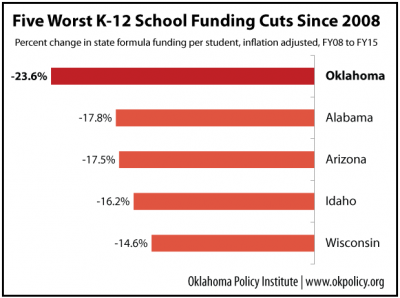
There’s Reason for Hope
Despite this shocking statement, I remain optimistic about the future of education funding. Tulsa has an ace up its sleeve that we’ve ignored for more than half a century, and it’s time we played that card. I’m talking about the land on which our city is built, and the fact that we have not come close to maximizing its value. (Don’t worry: I am NOT talking about turning park land into shopping centers!)
For clarification, let’s pay a visit to El Guapo’s Cantina.
In case you don’t know, El Guapo’s is one of several homegrown hits created by local restauranteur Elliot Nelson and The McNellie’s Group. It’s a Mexican restaurant that contributed to the rebirth of downtown Tulsa while celebrating Taco Tuesdays, rooftop dining, and surprisingly potent margaritas. They have two locations: the original one downtown, and a new south Tulsa restaurant at 81st and Harvard.
As it turns out, these two locations can teach us a lot about Tulsa Public Schools’ bottom line.
Doing the Math
First, we have El Guapo’s downtown, located on the southwest corner of 1st and Elgin. Built in 1912, this building occupies a typical 25 x 100 downtown lot, filling the entire 2,500 square foot parcel with a two-story building and a cool rooftop patio. According to the tax assessor’s website, the building contains 5,000 square feet of air conditioned space and pays annual property taxes of about $12,029. This means that every square foot of land associated with this modest building generates $4.81 in property taxes per year.
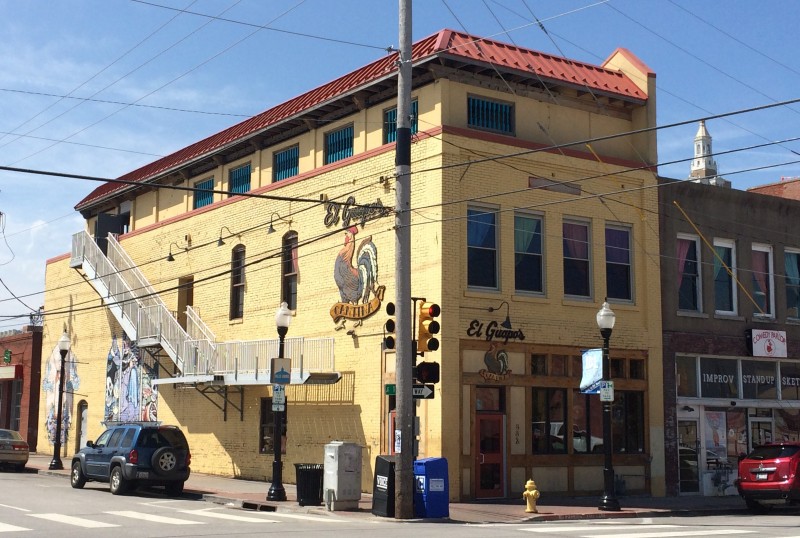
El Guapo’s downtown location – built in 1912
Next, we have the south Tulsa location near the southeast corner of 81st and Harvard. Built in 1979, this single-story building occupies 10,487 square feet of its 75,039 square-foot parcel. The remaining space (64,552 square feet) is dedicated to parking and landscaping. The entire parcel generates $15,899 in property tax revenue each year, which equals about $0.21 per square foot of land.
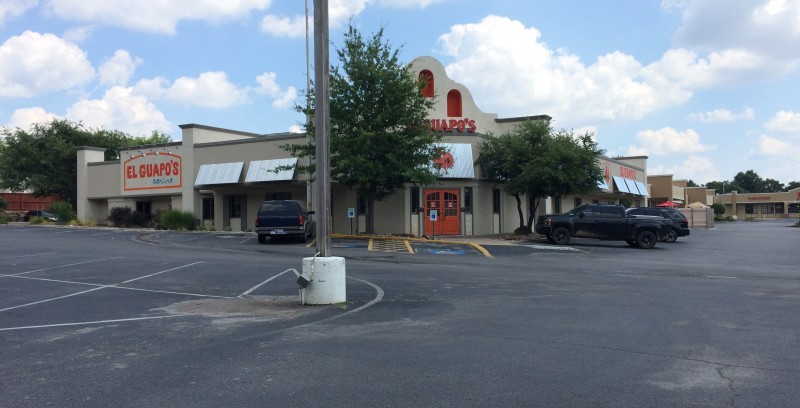
El Guapo’s south Tulsa location – built in 1979
To put this in perspective, El Guapo’s downtown generates approximately 23 times the amount of property taxes per square foot of land than the one located in a highly desirable south Tulsa location.
Have I got your attention yet? Educators… are you doing the math?
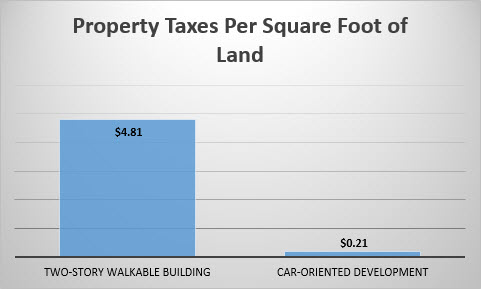
Sure, some of the difference is based on the relative value of downtown land, which can add a 40% premium over a similar parcel in the burbs. But that doesn’t explain the more than 2,000% premium on ad valorem taxes that we’re getting at the original El Guapo’s.
What really matters is how efficiently we’re using that space.
Walkable Places Generate More Taxes
Back in the day, people walked—and cities were built to accommodate this basic form of transportation. Blocks were smaller and parcels tended to be long and narrow, which allowed you to fit a lot of storefronts along a single block. Multi-story buildings were built up to the sidewalk, with doors and windows facing the street. All of this made it incredibly easy to walk from place to place, and people could live, work and shop within a compact area.
This development pattern was not only great for pedestrians; it was great for the city. The efficient use of land meant that it generated far more tax dollars than it cost to support. Tax revenue from these compact, multi-story buildings easily paid for the associated public services and infrastructure: roads, water, sewer, stormwater, police, fire, and—yes—schools.
Development patterns changed after World War II, when a combination of government policies (everything from local zoning codes to federal mortgage insurance regulations) incentivized suburban growth, while making old-fashioned, walkable places nearly impossible to build.
As the city spread out, zoning prevented us from mixing residential and commercial uses. People lived far from where they shopped and worked, driving became a necessity, and parking lots became the primary architectural feature of our city.
Too Much Parking Dilutes Revenues
Take another look at the two parcels our restaurants occupy. I’ve superimposed the downtown building onto the suburban shopping center to make it easy to visualize. (Scale is the same.)
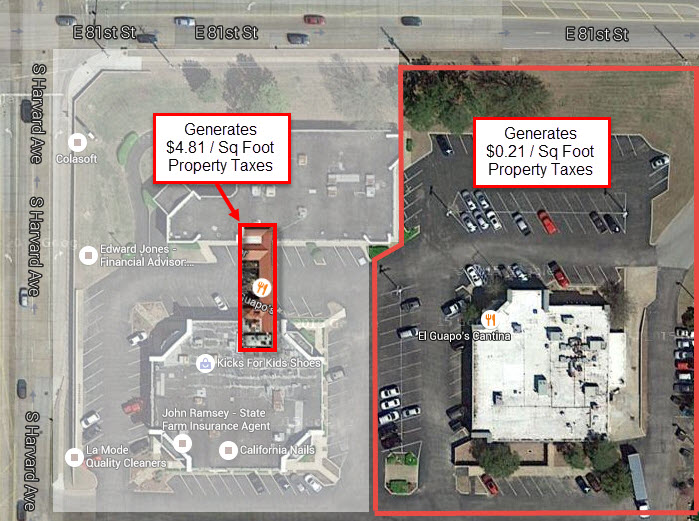
Comparison of traditional commercial building to modern shopping center.
El Guapo’s south includes dedicated parking for about 100 cars. El Guapo’s downtown includes space for zero. Amazingly, the downtown building is little more than one car-length wide. In fact, if the building were a parking lot, it could hold eleven cars.
I’ll let that soak in for a moment. Eleven cars.
In downtown Tulsa, there are no requirements to provide dedicated off-street parking. Instead, customers who drive rely upon hundreds of available parallel-parking spaces, nearby parking garages and shared parking lots. A growing population of downtown residents walk to dinner, and more and more people are choosing to bike. The building is also located close to several transit routes. This is a much more efficient system that allows people to choose their mode of transportation. At the same time, the market determines how much parking is needed, and includes the flexibility to allow spaces to be utilized both night and day by different users.
In the suburban model, every “use” provides its own dedicated off-street parking. Major streets are designed for fast moving vehicles, which doesn’t allow for on-street parking. And the buildings themselves are designed to be accessed solely by automobile. They are built on huge parcels of land, pushed back away from the street, and separated from the sidewalk by expansive parking lots.
This is great if you want to drive, but unfortunately, this single-purpose design limits our ability to utilize modes of transportation that would allow us to maximize the value of our land—and, thus, our tax revenues.
If You Care About Education Funding, You Should Care About Walkable Places
Because El Guapo’s downtown has two floors and a rooftop balcony, it functions as a 3-story building. It essentially occupies 300% of the land it sits on. Because the suburban site is a single-story building surrounded by parking, it occupies 14% of the available land. This makes a big difference to the tax assessor.
Which is why it should matter to you.
If you live in the Tulsa Public School district, about 50% of your property taxes go to support your local K-12 schools. Thus, if we want to raise an additional $50 million dollars for Tulsa Public Schools through ad valorem taxes, we would need to add about $100 million in taxable value to the land within our school district’s boundaries.
As shown above, the car-centric model of commercial development yields about $0.21 of property taxes per square foot of land, while an old-fashioned, walkable, two-story building generates about $4.81 per square foot. If we continue building our city like we did at 81st and Harvard, it would take 17 square miles of new development to increase our TPS budget by $50 million. However, it would only take ¾ of a square mile of dense, traditional, walkable buildings to achieve the same $50 million increase. (And that’s only considering 2-story buildings. Now imagine the multiplier if we built 3-story buildings!)
Think about that. Everyone can picture a square mile, because Tulsa is laid out on a grid. For example, 17 square miles would cover everything from 11th to 51st and Peoria to Sheridan, plus one more square mile thrown in for good measure. By contrast, three quarters of a square mile can be envisioned as 4th to 11th and Peoria to Delaware Ave.
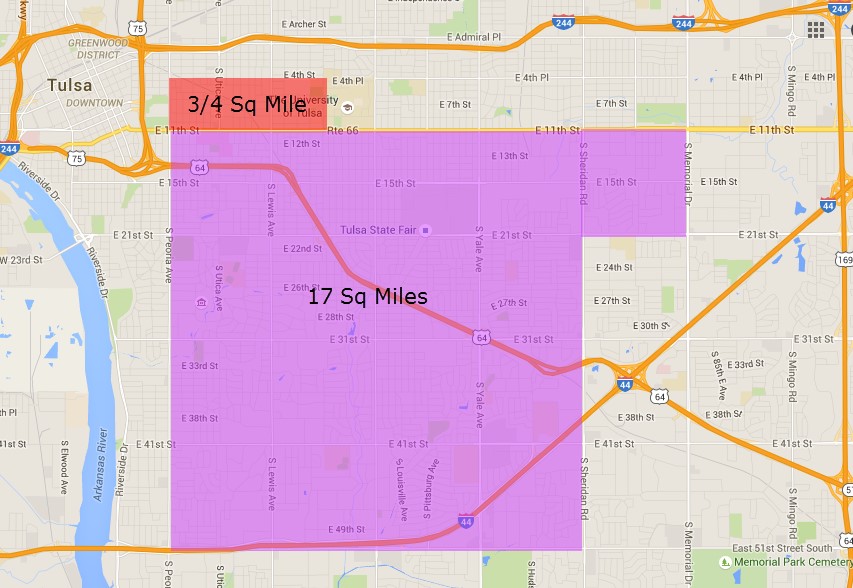
The amount of new land required to add $50 million to the education budget. Red shows traditional, walkable development. Purple shows car-oriented development.
Which option seems more realistic?
If you add up all the empty lots and under-utilized parcels of land in Tulsa, it’s easy to envision adding ¾ of a square mile of old-fashioned, high-quality, walkable infill throughout our city. Adding 17 square miles of car-centric development? Not so much.
We Need More Walkable, Bikeable, Transit-Friendly Places
If we want to solve our education budget crisis, the answer doesn’t lie solely in Oklahoma City. In fact, it’s right here in Tulsa, literally at our feet.
Building places that are conducive for walking, biking and transit is not just a good idea because people love them. It’s a moral imperative. Too much asphalt dilutes the value of land, and puts our schools in the red. A return to the traditional development patterns of the past will be the key to Tulsa’s future.
Some Good Things Are Already Happening.
For the first time in decades, Tulsa’s updated zoning code allows the possibility to create traditional, mixed-use, walkable places. In approving the recent Vision initiative, voters also supported a dedicated source of funding for transit. There’s also growing support for protected bike lanes and improved pedestrian infrastructure, along with a surge in ride share programs like Uber and Lyft. All of these are critical elements that will allow Tulsa to grow and increase our tax base without the downside of inefficient, car-centric development patterns.
But the status quo is a powerful force that will continue building wasteful sprawl unless we fight for change.
So whenever you see a vast, underutilized parking lot, you are looking at Tulsa’s future. Either we will continue to squander this land and the chance to fully fund public education, or we will return to our traditional roots, and build places that are great for people–and our schools’ bottom line.
by Sarah Kobos
Read MoreParking Vs. The Walkable Building (The Developer’s Dilemma)
John Anderson (R John the Bad, if you read his blog) is a guy who spent years trying to convince developers to care about walkable urbanism. As it turns out, the “brain damage” wasn’t worth it. A better approach, he decided, was to teach urbanists how to be developers. Which is how I met him last summer at the Congress for New Urbanism’s “Rookie Developers Breakfast.”
I wasn’t the only wannabe who showed up. Overwhelming interest in the topic inspired the creation of a Facebook group called Small Developer / Builders and a series of “Small Developer Boot Camps” led by John, Monte Anderson, and other members of the Incremental Development Alliance.
The lessons they teach would make Jane Jacobs dance on the sidewalk. Start small, keep it simple, build incrementally, foster local tradesmen, provide places for entrepreneurs, take the long view, invest in your neighborhood, and improve it one building at a time.
With each project, you enrich the soil of your “farm,” making the entire area more desirable and livable for you and all your neighbors. Monte Anderson, who has worked this sort of magic in his hometown of Duncanville, TX, calls it “gentle-fication,” a process that brings the community up with you in a gradual and sustainable way.
If you’re a regular Strong Towns reader, this probably makes a lot of sense. After all, this is how cities were traditionally built. People invested in the communities where they lived. Owner-occupants made incremental improvements with the expectation that their legacy would provide lasting value over time. It was never about making hedge fund investors rich from 3rd quarter profits of commodified real estate packages.
This return to an old-fashioned ideal is one of the things that makes small-scale development so appealing—especially to folks like me who care about good urban form, walkable places, and revitalizing neighborhoods. With low overhead and smart choices, it’s actually possible to build desirable places that normal people can afford. These projects help provide crucial “missing middle housing” that the big developers with their high overhead costs simply can’t deliver.
As John Anderson likes to say, “If you’ve ever found yourself eyeing an empty lot and thinking ‘Somebody ought to…’ Well, maybe that someone is you.”
IMPORTANT LESSONS FOR THE SMALL-SCALE DEVELOPER
But there are a couple important lessons that every starry-eyed dreamer/developer must consider.
First and foremost: if you can’t get the rent, you can’t build the building. So when calculating whether or not a project will “pencil,” you start with average rents and construction costs for your area, and work your way backwards to see what’s feasible. Everyone has sexy dreams, but as a developer it’s important to maintain a long-term, monogamous relationship with math.
The second lesson? “Keep it simple.” This encompasses everything from using commonly available construction materials to taking advantage of FHA loans. It also applies to site selection: whenever possible, you want to build “by right” on land that is already zoned for what you want to do.
Unfortunately, this is where a terrific aphorism crashes headfirst into the painful rock face of reality. Because most local zoning codes are ideally suited to building car-oriented crap, they are perfect for folks who like to transform large parcels of land into parking lots, shopping centers, and chain restaurants with drive thrus. Far too often, they conflict with the type of small-scale, walkable places our ancestors would recognize as home.
In cities throughout America, the places we love the best are often illegal to build. If you don’t believe me, test out your hometown zoning code by “building” a project on paper.
KICKING THE TIRES OF YOUR LOCAL ZONING CODE
That’s exactly what we did at a recent Small Developers Boot Camp in Bentonville, AR. We were given a portfolio of development opportunities taken from real life in Kalamazoo, MI. Our package included descriptions of various lots with prices based on comps; a market study of rental rates for commercial and residential spaces; average construction costs per SF; the current zoning for each parcel; and a “plain English” summary of the applicable zoning code requirements. Thus, we were able to compare lots while taking into account market realities and the nitty-gritty zoning requirements that can make or break a deal.
 Our mission: Decide what we wanted to build, pick an appropriate lot where we could build it by right with current zoning, and use a pro forma to check the math and see if the project makes money.
Our mission: Decide what we wanted to build, pick an appropriate lot where we could build it by right with current zoning, and use a pro forma to check the math and see if the project makes money.
As aspiring small developers, we first looked for affordable, modest-sized lots, where adding a single building would help complete a missing piece of the neighborhood puzzle. This allowed us to quickly reject big, expensive parcels that were beyond our means.
A glance at the zoning code helped us dismiss other locations.
We wanted the option to build residential over commercial, but this was not allowed in several of the purely residential zoning districts. Minimum Lot Area Per Dwelling Unit (basically, how much land you need per residential unit) and setback requirements (how far back from a lot line you have to build) further limited our choices.
THE DEVIL IS IN THE DETAILS. IT’S ALSO IN TABLE 4.1-A OF YOUR LOCAL ZONING CODE
I have to say, the Minimum Lot Area requirements surprised me the most. We envisioned a compact, mixed-use building with up to three stories and six dwelling units combined with ground-floor retail. But even in a traditional neighborhood where the existing building stock matched our vision, we were limited to three residential units because of this arbitrary restriction.
We would have loved having those extra units, and I’m sure Kalamazoo would have appreciated the extra property taxes our ideal project could have generated—but the code said “no!” (Take that, local schools!)
Ultimately, we decided to test a two-story, mixed-use building with residential above retail, just like the adjacent older buildings, but smaller. For the purpose of our quick estimate, we assumed we would build three 800 SF residential units above 2,400 SF of commercial space on the ground floor, which could be divided into two or three separate storefronts if desired. It wouldn’t maximize use of the space, but it would fill in a “missing tooth” on what was once a lively, walkable street.
PARKING V. BUILDING
Next came off-street parking requirements–and the audible groans and outcries of our merry band of aspiring developers. The parcel we selected was zoned “Commercial Neighborhood” which included a lovely statement of intent: “to promote pedestrian-oriented development” and“encourage small-scale retail sales and personal services to primarily serve nearby residential neighborhoods.”
Of course, nothing says “pedestrian-oriented development” like a vast amount of off-street parking!
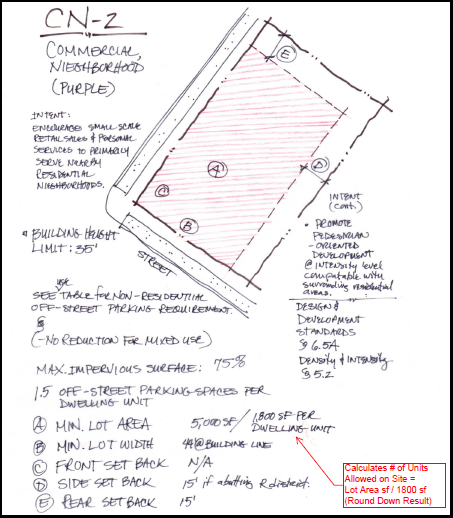 “Let’s make car storage the primary function of our city!” exclaims absolutely no one ever. Unfortunately, the zoning code does. Which is why most cities say they want walkability, but require a ridiculous amount of off-street parking.
“Let’s make car storage the primary function of our city!” exclaims absolutely no one ever. Unfortunately, the zoning code does. Which is why most cities say they want walkability, but require a ridiculous amount of off-street parking.
In our case, each one-bedroom unit required 1.5 off-street parking spaces. Thus, our three apartments needed five total parking spaces (of course, you have to round up). The commercial parking requirements were even worse. It was a moving target based on “use.” Would the commercial space be used as offices? Retail? A coffee shop, restaurant or bar? How could we even know? (None of us brought a Magic 8 Ball to the workshop.)
DOING THE MATH…
The commercial off-street parking requirements ranged from one space per 330 square feet of office floor area to one space per 100 square feet of restaurant. At a minimum, we would be required to provide 7 parking spaces for our 2,400 SF of commercial space. If a tenant wanted to use this space for a bar, we would need 24 parking spaces—because drinking and driving is oddly enshrined in most zoning codes.
All together (calculating residential and commercial) we would need parking for 11 to 29 cars for our little building. And since it takes about 300 SF of land for every parking space (which includes the stall plus associated drive aisles) we would need between 3,300 and 8,700 square feet of land dedicated solely to parking.
Did I mention that our parcel was only 6,752 SF? And we wanted to include a building?
After a lot of sketching and scratching of heads, we managed to fit our building and 10 parking spaces on the lot. Close, but no cigar in our attempt to fulfill the requirements of the zoning code and build “by right.” In real life, that single space we lacked would require a trip to the Board of Adjustment to beg for a variance.
I’LL TAKE PARKING FOR 100, ALEX…
Our story is not unique. Throughout the country, you’ll find zoning codes quite similar to those in Kalamazoo. Because it’s expensive and tedious to overhaul zoning ordinances, they tend to fossilize over time. Unfortunately, many of them appear to be trapped in a geologic formation that includes beehive hairdos, transistor radios, and the 22-volume 1971 World Book Encyclopedia.
Thus, zoning ordinances still require off-street parking to “lessen congestion in the public streets” as if promoting auto travel is a scientifically proven method for eliminating traffic. And while some cities are beginning to reduce off-street parking ratios, only a brave minority have taken the plunge to eliminate them altogether.
So even if those parking spots aren’t needed, they are required. Which basically sucks for everyone except the guy who lays the asphalt. It limits the ability of developers to build small-scale infill projects that contribute to walkable neighborhoods. It incentivizes driving, while punishing people who walk, bike and use transit. And it dilutes property tax revenues because asphalt is never the highest and best use of land.
You’d think this problem would be easy to fix. But if you’ve ever doubted that the pen is mightier than the sword, just try to change a few words in your local zoning code. People will show up in force to protect the status quo as if defending against a zombie apocalypse.
Which is funny, because most folks don’t have a clue what the zoning code actually says or how it impacts their daily lives.
Reading your local zoning ordinance is a powerful soporific; it will induce sleep faster than a Benadryl with bourbon. But it is also, literally, the law of the land—a regulatory document that determines how buildings, neighborhoods and cities will evolve over the coming decades.
If you care about your city’s future, you care about the zoning code.
If we want that future to include small-scale, incremental development that creates walkable places, while building local wealth and improving traditional neighborhoods, we need to make sure our zoning codes enable that vision.
It might be time for a review. Grab a coffee and a copy of your zoning code, and get busy!
Read MoreSo Many Shoppers, So Much Unused Parking
Back when I was a kid, we didn’t have Black Friday. We had after-Christmas specials. (At our house, the day after Thanksgiving was reserved for turkey tetrazzini and leftover pie.) The preferred shopping day for thrifty folks like my mom was the day after Christmas. A child of the Depression, she never met a 75% discount that she didn’t like. As a result, many of our Christmas gifts were purchased 364 days in advance, and squirrelled away until the following yuletide season.
I’m not sure exactly when the Black Friday craze began. Having never wrestled anyone to the ground for a Cabbage Patch Kid or fought to the death for a Gameboy, I’m pretty sure I missed out on the earliest incarnations of holiday shopping hysteria.
Even now, with all the media hype, I remain unconvinced that Black Friday actually exists.
We’re told that this is the “biggest shopping day of the year”—yet parking lots across the country tell a different story. Last year, I set out to explore #BlackFridayParking at commercial shopping centers across Tulsa to see for myself.
As I drove around town, the empty parking lots had me doubting Black Friday almost as much as I doubt the fat man in the red suit himself. Further research was needed. I was actually going to have to go shopping on Black Friday. (If you’re like me, the day you realize you can buy your favorite brand of underwear online is the day you celebrate never having to step inside a department store ever again. I really hate shopping.)
I headed to Tulsa Hills, one of our newest and most popular shopping centers, to check out the Black Friday madness. It was early afternoon and Dicks Sporting Goods was doing a brisk business, so—like Jane Goodall plunging into the Tanzanian jungle—I stepped through the automatic sliding glass doors to study Americans in their native habitat: the aisles of a big box store.
It was definitely crowded. The aisles were full of people browsing for everything from basketballs to badminton sets. Treadmills were being tested. Folks stood in line, arms loaded with yoga mats and sweatpants, waiting for cashiers. This was clearly no ordinary shopping day.
Visits to other stores yielded similar results. So yes, Virginia, there really is a Black Friday. But if this is truly the busiest shopping day of the year, why aren’t the parking lots full?
For years, we’ve been told that parking lots need to be large enough to accommodate peak parking demand. Sure, they’re not full on any given Tuesday, but we really need them on those big shopping days! (Or so the developers claim, as they tear down residential housing for commercial parking spaces that will never be used.)
On Black Friday, the Dick’s Sporting Goods store I visited had 155 empty parking spaces in their 261 space parking lot. This means that, on what is purported to be the busiest shopping day of the year, 62% of the available parking spaces were vacant.
Dick’s was not alone. Everywhere I went, I found oceans of empty asphalt, despite crowds of eager shoppers bustling inside the stores.
So what’s up with that?
My initial thought was to blame our local zoning ordinance for its high parking minimums. And while this is certainly a factor, it doesn’t appear to be the actual cause. As it turns out, national chains have their own development standards, which often far exceed local zoning requirements.
In Tulsa’s recently updated zoning code, parking requirements received a makeover. A retail store in a commercial shopping district is required to provide a minimum of 2.5 or 3.33 spaces per 1,000 SF of building. (The lower number is for CH and Mixed-Use zoning, which includes many of our older/historic “main streets.” In these areas, the first 5,000 SF of building space is exempt from parking requirements. Downtown has no parking requirements whatsoever.) While Donald Shoup would correctly argue that these requirements are both precise and wrong, they are a big improvement over our previous zoning code that required even more parking and treated every neighborhood like a 70’s suburb.
Here’s the rub. Many national retailers require around 5 parking spaces per 1,000 SF of building size. This is true of national chains as diverse as REI and PETCO, and it appears to be the case for Dick’s Sporting Goods, which has 261 parking spaces serving its 50,220 SF building.
Since every parking space takes up about 300 SF of land (once you factor in driveways and aisles), this means that every 50,000 SF of building area is accompanied by over 75,000 SF of asphalt.
And on Black Friday, when the parking lot at Dick’s was 60% vacant, it means that 46,500 SF of space—an area nearly as large as the store itself—sat empty.
That’s a lot of space to waste on the “busiest shopping day of the year.” But it’s nothing compared to a “normal” shopping day, which looks something like this:
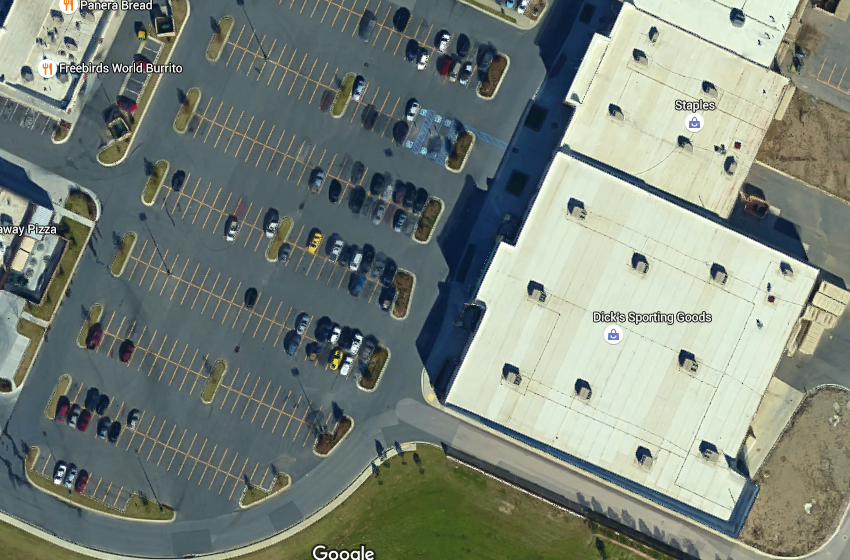
Why do I care? Because all that wasted space means we’re building and maintaining a lot more public infrastructure than we need. If you’ve been following the Strong Towns movement, it makes you think. When every destination is bloated by excessive parking, cities must provide and maintain additional miles of roadway, and manage more water, sewer and stormwater lines than they otherwise would. At the same time, we receive fewer tax dollars per acre of land within our city limits because of the poor use of space. It’s an inefficient system that hits municipalities–and taxpayers–directly in the pocketbook.
All this just because a bunch of national chains want twice as much parking as they need on the busiest shopping day of the year.
Maybe it’s time we started paying closer attention to the math.
By Sarah Kobos
Read MoreDoes That Parking Space Come with Fries?
Imagine living in a city where every restaurant is required by law to provide free chicken sandwiches. In addition to the free sandwiches, each restaurant offers a complete menu of items available for purchase. You can order roast beef or a reuben or an Albuquerque Turkey—but you have to pay for them.
The chicken sandwiches, however, are always free. And each day, restaurants must provide more than twice as many chicken sandwiches as their customers will eat. A majority of the sandwiches go to waste.
This would be absurd, right? What kind of communist plot would require a business to offer sandwiches for free?
Well, nearly every town in America does it. But they don’t require free sandwiches, they require something much more valuable: free parking.
But we need free parking…don’t we?
Even if they’re located next to a bus stop, or a bike route, or a residential neighborhood where their customers live, businesses across America must purchase extra land to build parking lots. Often, they must demolish existing buildings to do so. And while zoning ordinances don’t specifically require the parking to be free, we’ve built so much of the darn stuff, we’ve devalued it. People have come to expect free parking wherever they go. As a result, it’s a rare business that dares to charge for parking.
I’m sure you’re thinking: but we need all that parking! Everybody drives to the store!
It’s true, lots of folks drive. Why? Perhaps it’s time to revisit that town with the free sandwiches.
If chicken sandwiches are offered for free (while every other item on the menu costs money) what does that do to demand?
I think it’s fair to say that a lot more folks would eat chicken sandwiches in our imaginary town, even if they preferred pastrami on rye. Because a free sandwich is a free sandwich!
“A fertility drug for cars.”
In much the same way, when we require abundant off-street parking, but we don’t require infrastructure that supports transit, cycling or walking, we impact demand. Our zoning code essentially dictates that developments prioritize cars over people. So what do we get? A city full of cars.
As Donald Shoup famously wrote, “Minimum parking requirements act like a fertility drug for cars.”
And because we put the needs of cars before those of people, we require buildings to be set back far from the sidewalk. We require enormous parking lots located between the building and the street. We expect pedestrians and transit users to traverse asphalt wastelands and share space with speeding SUVs.
We make driving convenient and seemingly “free.” We make every other alternative inconvenient and unpleasant, and then we charge for transit. We are handing out the chicken sandwiches and wondering why so few people choose soup or salad.
But is all this parking actually “free?”
(The true cost of car ownership is a topic for another day, so let’s just focus on parking.)
Back to our imaginary town…
To offset the cost of free chicken sandwiches, restaurants would need to increase the price of every other item on the menu. Drinks, soups, salads, burgers—every other item would cost more because the chicken sandwiches were free.
It’s the same with parking: we all pay for it–whether we drive or not.
We pay because the price of goods and services includes the cost of all that free parking.
Gratuity included. Hidden fees may apply.
As communities, we pay because abundant parking makes land less productive. More asphalt means fewer businesses, fewer jobs, and fewer tax dollars per acre.
In addition, our tax dollars are spent to build and maintain roads so all those cars can travel from one “free” parking space to another. And the more parking you require, the further everyone must drive. Businesses and destinations are separated by great distances because of the space needed for parking.
Spreading out these destinations means that our tax dollars must fund additional miles of roadway. We also must provide and maintain more water, sewer, and stormwater pipe; more pumping stations; more fire stations; more police officers…. You get the idea.
It’s an inefficient system, and it needs to stop.
Since 1963, the population of the City of Tulsa has increased by about 30%. In this time, our city’s geographic area has expanded by approximately 300%. Most of this growth has come in the form of low-density, inefficient, suburban sprawl.
Thanks to parking minimums, approximately 2/3 of our commercial space is covered in asphalt. The remaining 1/3 of the commercial land cannot possibly generate all the taxes, jobs and commerce needed to support our city’s needs. We have built a lot of infrastructure for so few taxpayers.
And it makes for an awfully expensive free sandwich.
Read MoreUnhealthy by Design
For the first time in our history, we are raising a generation of kids who will have a shorter lifespan than their parents.
Take a moment and let that sink in.
It’s a startling fact.
Historically, the challenge for public health officials was the fight against infectious diseases. In 1900, the leading causes of death included pneumonia, tuberculosis, and some nasty intestinal maladies I’d rather not get into. (No need to gross everyone out.) Let’s just say that no amount of Pepto Bismol was going to help.
Happily, we spent the 20th century developing solutions to these problems. We created clean water and sanitary sewer systems. We developed antibiotics and immunizations. We learned about the importance of proper ventilation, hygiene and sanitation practices. Combined with increased worker and consumer safety regulations, these changes added 25 years to the average American’s lifespan.
Today that lifespan is decreasing. And now we have a totally different public health crisis: chronic diseases linked to inactivity and obesity.
In 2014, the leading causes of death were heart disease, cancer, lower respiratory disease, and stroke. Although diabetes is 7th on the list, the number of people with diabetes has tripled since 1994 with no end in sight. It’s estimated that by 2030—if trends don’t improve—more than 80% of Americans will be overweight or obese.
The Evolution of Inactivity
So what changed? Why, despite advances in drugs and medical procedures, are people less healthy today than 20 years ago? Why, despite all our focus on diet and healthy eating, are we gaining weight?
One major factor is the amount of physical activity we get.
Since 1994, the number of Americans reporting absolutely NO physical activity has increased from 17% to 52%.
Which just happens to be directly related to the amount of time Americans spend sitting in their cars.
Since 1980 the number of vehicle miles traveled has doubled.
If you look at the way we design our cities it’s no wonder. We’ve spent the past several decades prioritizing the needs of cars over the needs of people. We’ve designed inactivity and auto-dependence into our daily lives.
Convenient for Cars; Deadly for Humans
Instead of wide, tree-lined sidewalks and bike lanes, we get multi-lane roads designed for high-speed travel by automobiles. Instead of corner cafes and coffee shops, we get drive-thrus in the middle of asphalt oceans. Instead of buildings lining our main streets, we get businesses that are pushed back behind an obscene display of surface parking. Instead of homes on modest sized lots with connected street grids, we have giant yards on cul-de-sacs. And instead of building housing near schools, shopping and jobs, we separate each use—as if in fear of cross-contamination.
Our cities have been evolving to meet the needs of automobiles for over 50 years. Unfortunately, our bodies have evolved over a much longer period for a different purpose.
The human body is designed for action. We’re built to walk. We’re meant to be active. And while we’ve become more and more sedentary in recent decades, our inactivity comes at a cost.
If you need hard facts, try this one on for size. According to the American Diabetes Association, the cost of diabetes (direct medical costs and reduced productivity) has risen from $174 billion in 2007 to $245 billion in 2013, a 41% increase in just five years.
The Human Habitat
If we want to change our habits, we’re going to have to change the way we design our human habitats.
We’re going to have to start building places that are great for walking, biking and transit. We’re going to have to put the needs of people above the needs of automobiles.
The Urban Land Institute has put together a toolkit for “Building Healthy Places.” It includes a list of common sense solutions to help make our cities and towns healthier places to live. These include old-fashioned ideas like:
- Incorporate a mixture of land uses (don’t separate everything from everything else)
- Design well-connected street networks at the human scale (make it easy to get from place to place without a car)
- Provide sidewalks and enticing, pedestrian-oriented streetscapes (don’t punish people for walking)
- Provide infrastructure to support biking (burn calories, not gas)
It’s a great place to start the conversation. Other resources include The Center for Active Design and 8-80 Cities.org.
Americans need to get active. The beautiful thing about thoughtful urban design is that the activity is baked into your day. You don’t need a gym membership if you can bike to work or walk to dinner.
Now that’s food for thought.
Read More